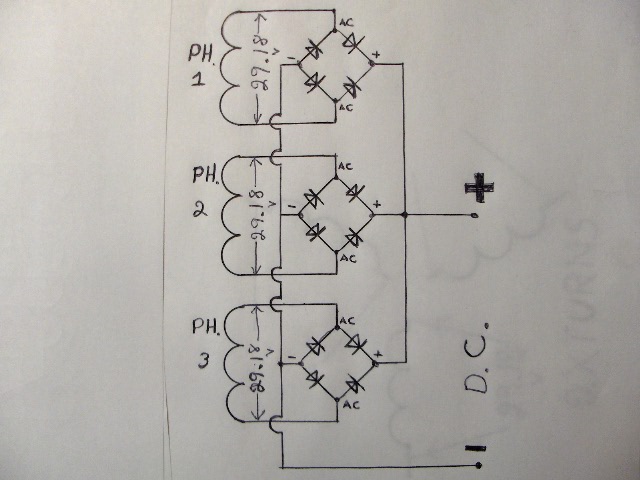Hi Hugh.
Thanks for stoping by. There are several diaries pertaining to this topic. It goes back a mounth or so.
I had a thought so I did a few expiriments. After looking at both delta and star I was wondering why stars voltage is 1.73 times that of delta. The answer is very simple. We are taliking 3 phase here. So then its quite logical that all the phase are out of phase by 120 degrees.
My first concern was. If I have 2 coils producine 10 volts and I wire them in sires(star) I don't get 20v I get 17.30 volts. I concider that a losse.
So I concluded, If I make the delta voltage 20, this is what the 2 star coils would be if they were in phase, then I have gotting the 20 volt that I should have. At any given time only 2 star coils are working together but even at that point neither one is at full potential. That explains the 17.30 volts rather than 20.
The delta/jerry is basicly delta with the exception the 3 phase don't share a commom fullwave bridge. Each has it own. This in turn is equal to 3 sperate dc sources and the total of ther dc output is not degraded by pasing its curent though a neiboring out of phase coil.
The voltage is 20 not 17.3v and since all 3 dc are peralelled there amperage adds up.
The amperage in star is that of 2 out of phase coils wired sires.
I stated it this way. Three 20 volt 5 amp coils in perelell(the diodes provide the seperate but dc perelell conection) = 20v at 15 amps this is delta/jerry riged. Star on the other hand would be = to 2 10 volt 10 amp coils wired sires for 17.3 volts at 10 amps.
So I've put this to the test and gues what into a battery load thats the results I get. I've done this with a modifide GM car alt with a NEO stator, a small 3 coil 3 phase dual rotor disc alt and my latest is a 6 pole, 6 slot ac motor conversion with only 3 coils 120 degrees apart wound with 2 in hand 21 gage wire. This alows a normal star conection and a delta/jerry riged conection in the same alt. Open ac voltage for star 6.149v and open voltage for delta/jerry riged 6.729.
The loss in star voltage is right on track. Wattage test. 500 rpm wattage into a 6 volt golf cart battery, star 6.62 watts, delta/jerry riged 11.99 watts.
The results have been very simular in all 3 alts. It has been sugjested that to be fair to star and make up for its lose in voltage I need to wind a few more turns of wire. I did that in the small 3 coil dual rotor disc alt and star was still did less power into a battery load same rpm.
My plan is to wind a few more turns for star in my curent alt to give star the helping hand, it has been sugjested that star needs.
AS far as power requiered to operate a more powerfull alt. I'm aware of that.
After the helping coil for star is wound I may do a small wind tunnel test with a 49" blade and track mph and power out of the 2 phase types. This will be some time off however.
This is basicly a rehash of this subject that has been gone ever many times allready.
Here is the scimatic of the delta/jerry riged conection. I'm sure you've seen this befor.

Your thoughts are greatly apriciated.
JK TAS Jerry